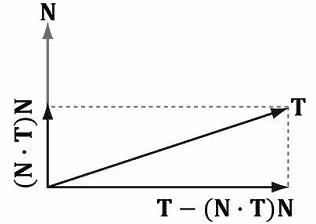18.6 着色器代码
我们将法线贴图映射的一般处理过程总结如下:
1.使用某个绘图软件或工具软件创建法线贴图,并保存为图像文件。当程序初始化时,从这些文件创建2D纹理。
2.为每个三角形计算切线向量T。在网格中,顶点v的切线向量等于共享该顶点的每个三角形的切线向量的平均值。(在我们的演示程序中,我们为简单几何体直接指定切线向量,为那些从3D建模软件导出的复杂三角形网格计算平均值。)
3.在顶点着色器中将顶点的法线向量和切线向量变换到世界空间,然后将结果输出到像素着色器。
4.使用插值后的切线向量和法线向量,为三角形表面上的每个像素点生成TBN基。使用TBN基,将从法线贴图采样得到的法线向量从切线空间变换到世界空间。最后将法线向量用于光照计算。
要实现法线法线贴图映射,我们需要在lighthelper.fx中添加以下函数:
//-------------------------------------------------------------------------------------
// 将法线贴图的采样值转换到世界空间.
//-------------------------------------------------------------------------------------
float3 NormalSampleToWorldSpace(float3 normalMapSample, float3 unitNormalW, float3 tangentW)
{
// 将每个分量从[0,1]解压到[-1,1].
float3 normalT = 2.0f*normalMapSample - 1.0f;
// 创建TBN基.
float3 N = unitNormalW;
float3 T = normalize(tangentW - dot(tangentW, N)*N);
float3 B = cross(N, T);
float3x3 TBN = float3x3(T, B, N);
// 从切线空间转换到世界空间.
float3 bumpedNormalW = mul(normalT, TBN);
return bumpedNormalW;
}
这个函数在像素着色器中的使用方法如下:
float3 normalMapSample = gNormalMap.Sample(samLinear, pin.Tex).rgb; float3 bumpedNormalW = NormalSampleToWorldSpace(normalMapSample, pin.NormalW, pin.TangentW);
这里有两行代码需要特别说明一下:
float3 N = unitNormalW; float3 T = normalize(tangentW - dot(tangentW, N)*N);
在插值之后,切线向量和法线向量可能不再相互垂直。这两行代码的用途是通过从T中减去偏向于N的部分(见图18.6),使T重新垂直于N。注意,我们假设unitNormalW已被规范化。

在从法线贴图中获取了法线之后,就可以将它用在所有包含法线向量的计算中(即,光照、立方贴图映射)。我们将整个法线贴图映射的effect代码都列了出来。
#include "LightHelper.fx"
cbuffer cbPerFrame
{
DirectionalLight gDirLights[3];
float3 gEyePosW;
float gFogStart;
float gFogRange;
float4 gFogColor;
};
cbuffer cbPerObject
{
float4x4 gWorld;
float4x4 gWorldInvTranspose;
float4x4 gWorldViewProj;
float4x4 gTexTransform;
Material gMaterial;
};
// Nonnumeric values cannot be added to a cbuffer.
Texture2D gDiffuseMap;
Texture2D gNormalMap;
TextureCube gCubeMap;
SamplerState samLinear
{
Filter = MIN_MAG_MIP_LINEAR;
AddressU = WRAP;
AddressV = WRAP;
};
struct VertexIn
{
float3 PosL : POSITION;
float3 NormalL : NORMAL;
float2 Tex : TEXCOORD;
float3 TangentL : TANGENT;
};
struct VertexOut
{
float4 PosH : SV_POSITION;
float3 PosW : POSITION;
float3 NormalW : NORMAL;
float3 TangentW : TANGENT;
float2 Tex : TEXCOORD;
};
VertexOut VS(VertexIn vin)
{
VertexOut vout;
// Transform to world space space.
vout.PosW = mul(float4(vin.PosL, 1.0f), gWorld).xyz;
vout.NormalW = mul(vin.NormalL, (float3x3)gWorldInvTranspose);
vout.TangentW = mul(vin.TangentL, (float3x3)gWorld);
// Transform to homogeneous clip space.
vout.PosH = mul(float4(vin.PosL, 1.0f), gWorldViewProj);
// Output vertex attributes for interpolation across triangle.
vout.Tex = mul(float4(vin.Tex, 0.0f, 1.0f), gTexTransform).xy;
return vout;
}
float4 PS(VertexOut pin,
uniform int gLightCount,
uniform bool gUseTexure,
uniform bool gAlphaClip,
uniform bool gFogEnabled,
uniform bool gReflectionEnabled) : SV_Target
{
// Interpolating normal can unnormalize it, so normalize it.
pin.NormalW = normalize(pin.NormalW);
// The toEye vector is used in lighting.
float3 toEye = gEyePosW - pin.PosW;
// Cache the distance to the eye from this surface point.
float distToEye = length(toEye);
// Normalize.
toEye /= distToEye;
// Default to multiplicative identity.
float4 texColor = float4(1, 1, 1, 1);
if(gUseTexure)
{
// Sample texture.
texColor = gDiffuseMap.Sample( samLinear, pin.Tex );
if(gAlphaClip)
{
// Discard pixel if texture alpha < 0.1. Note that we do this
// test as soon as possible so that we can potentially exit the shader
// early, thereby skipping the rest of the shader code.
clip(texColor.a - 0.1f);
}
}
//
// 法线映射
//
float3 normalMapSample = gNormalMap.Sample(samLinear, pin.Tex).rgb;
float3 bumpedNormalW = NormalSampleToWorldSpace(normalMapSample, pin.NormalW, pin.TangentW);
//
// Lighting.
//
float4 litColor = texColor;
if( gLightCount > 0 )
{
// Start with a sum of zero.
float4 ambient = float4(0.0f, 0.0f, 0.0f, 0.0f);
float4 diffuse = float4(0.0f, 0.0f, 0.0f, 0.0f);
float4 spec = float4(0.0f, 0.0f, 0.0f, 0.0f);
// Sum the light contribution from each light source.
[unroll]
for(int i = 0; i < gLightCount; ++i)
{
float4 A, D, S;
ComputeDirectionalLight(gMaterial, gDirLights[i], bumpedNormalW, toEye,
A, D, S);
ambient += A;
diffuse += D;
spec += S;
}
litColor = texColor*(ambient + diffuse) + spec;
if( gReflectionEnabled )
{
float3 incident = -toEye;
float3 reflectionVector = reflect(incident, bumpedNormalW);
float4 reflectionColor = gCubeMap.Sample(samLinear, reflectionVector);
litColor += gMaterial.Reflect*reflectionColor;
}
}
//
// Fogging
//
if( gFogEnabled )
{
float fogLerp = saturate( (distToEye - gFogStart) / gFogRange );
// Blend the fog color and the lit color.
litColor = lerp(litColor, gFogColor, fogLerp);
}
// Common to take alpha from diffuse material and texture.
litColor.a = gMaterial.Diffuse.a * texColor.a;
return litColor;
}
文件下载(已下载 940 次)
发布时间:2014/8/24 下午3:56:47 阅读次数:4938
